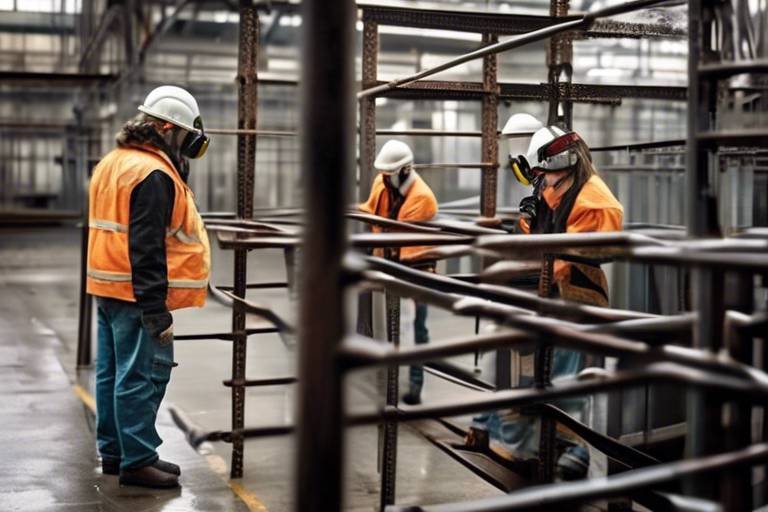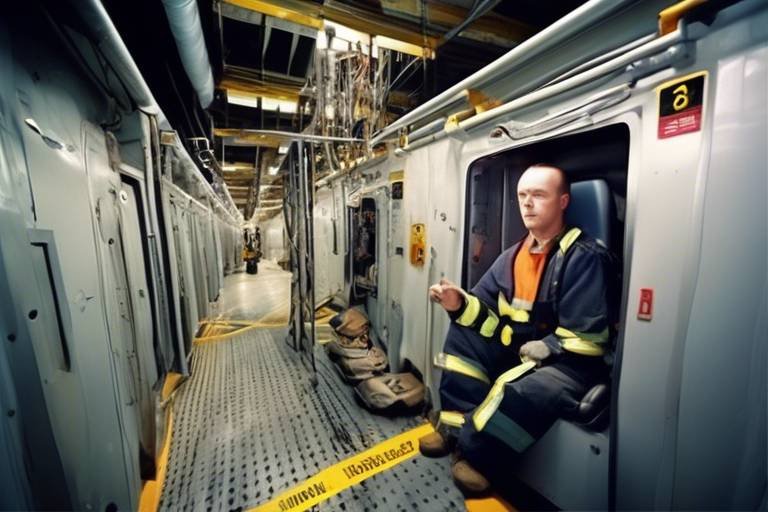Understanding the Role of Human Behavior in Safety Practices
In today's fast-paced world, the significance of human behavior in shaping safety practices cannot be overstated. Whether in a bustling workplace, a construction site, or even at home, the decisions we make and the actions we take can either enhance or undermine safety protocols. Understanding the psychological factors that influence behavior is crucial for organizations aiming to minimize accidents and foster a culture of safety. It’s not just about following rules; it’s about creating an environment where safety becomes a natural part of daily routines.
Consider this: why do some individuals consistently adhere to safety guidelines while others seem to disregard them? The answer often lies in a complex interplay of cognitive and emotional factors. For instance, an employee who feels valued and respected is more likely to engage in safe practices than one who feels overlooked or unappreciated. This connection between emotional well-being and safety behavior is a critical area for organizations to explore. By addressing these psychological aspects, companies can create a more effective safety culture that resonates with their workforce.
Furthermore, the environment plays a pivotal role in shaping behavior. A workplace that prioritizes safety through visible measures—like proper signage, regular training, and accessible safety equipment—can significantly influence how employees perceive and act on safety rules. It’s akin to setting the stage for a play; when the environment is conducive to safety, individuals are more likely to perform their roles effectively. Therefore, creating a supportive atmosphere is essential in promoting safe practices.
As we delve deeper into the topic, it becomes clear that understanding human behavior is not merely an academic exercise; it is a practical necessity. Organizations that invest time and resources into comprehending the psychological underpinnings of their employees' actions can reap substantial rewards. Improved safety outcomes lead to fewer accidents, reduced costs, and a more engaged workforce. In the following sections, we will explore specific strategies and programs that can be implemented to harness the power of human behavior in safety practices.
Examining how psychological principles influence safety behaviors, we find that cognitive biases, emotional states, and individual experiences all play a role in shaping how people approach safety. For example, the availability heuristic may cause someone to underestimate risks if they have not personally experienced an accident. Similarly, fear or anxiety can lead to either over-cautiousness or reckless behavior, depending on the individual's personality and past experiences.
Moreover, understanding these psychological factors can help organizations tailor their safety training and communication strategies. When employees comprehend the rationale behind safety measures—rather than viewing them as mere rules—they are more likely to embrace and internalize safe practices. This shift in perspective can transform safety from a compliance issue to a personal commitment.
Behavioral safety programs are designed to address the human element of safety by actively engaging employees in the process. These programs focus on identifying safe and unsafe behaviors and implementing strategies to encourage positive actions. By fostering a culture of safety, organizations can significantly reduce the likelihood of accidents and injuries. The key to success lies in understanding that safety is not just about rules and regulations; it’s about people and their behaviors.
One of the most effective strategies for promoting safe behaviors is through positive reinforcement. This approach involves recognizing and rewarding employees for adhering to safety protocols, thereby encouraging them to continue these behaviors. For instance, a company might implement a reward system where employees receive points for reporting unsafe conditions or consistently wearing personal protective equipment (PPE). These points could then be exchanged for prizes, creating a fun and engaging incentive.
Numerous organizations have successfully utilized positive reinforcement to enhance their safety outcomes. For example, a manufacturing company that introduced a monthly safety award saw a significant decrease in workplace incidents. Employees were motivated not only by the rewards but also by the recognition of their commitment to safety, illustrating the profound impact of positive reinforcement.
However, implementing positive reinforcement techniques is not without its challenges. Organizations may encounter resistance from employees who are skeptical of the program's effectiveness or feel that rewards are insufficient. To overcome these hurdles, it’s essential to communicate clearly about the program's goals and benefits, ensuring that all employees understand its purpose. Engaging employees in the development of the program can also foster a sense of ownership and commitment.
Training and education are paramount in shaping safe behaviors. Effective training programs not only provide employees with the knowledge they need to recognize hazards but also empower them to take action. By using interactive methods—such as simulations, role-playing, and hands-on exercises—organizations can create a more engaging learning experience that resonates with employees.
Leadership plays a crucial role in establishing and maintaining a strong safety culture. The behaviors and attitudes of leaders set the tone for the entire organization. When leaders prioritize safety and model safe behaviors, employees are more likely to follow suit. This is not just about compliance; it’s about creating a shared value system where safety is regarded as a collective responsibility.
The visible commitment of leaders to safety can inspire employees to adopt safer behaviors and practices. When leaders actively participate in safety training, conduct safety audits, and engage in open discussions about safety concerns, they demonstrate that safety is a top priority. This kind of leadership fosters trust and encourages employees to voice their concerns, ultimately leading to a safer work environment.
Effective communication is vital in promoting safety. Clear and consistent messaging helps employees understand the importance of safety protocols and their role in maintaining a safe workplace. Organizations should utilize various communication channels—such as newsletters, meetings, and digital platforms—to reinforce safety messages. By ensuring that these messages resonate with employees, organizations can enhance their safety culture.
- What is the importance of human behavior in safety practices?
Human behavior significantly influences safety practices, as individuals' decisions and actions can either enhance or undermine safety protocols. - How can organizations improve their safety culture?
By understanding psychological factors, implementing behavioral safety programs, and fostering strong leadership commitment, organizations can enhance their safety culture. - What role does training play in safety?
Training equips employees with the knowledge and skills necessary to recognize hazards and take appropriate actions to ensure safety.

The Psychology of Safety
Understanding the psychology of safety is crucial for creating effective safety practices in any environment. It’s fascinating how the mind works when it comes to assessing risk and making decisions. Have you ever found yourself in a situation where your gut feeling told you something was unsafe, yet you proceeded anyway? This inner conflict is a common human experience, often influenced by various cognitive and emotional factors. Our perceptions of safety can be swayed by past experiences, social influences, and even the environment around us. For instance, if we see others engaging in risky behavior without immediate consequences, we might be tempted to follow suit, disregarding the potential dangers.
One of the key aspects of safety psychology is risk perception. People evaluate risks based on their experiences, knowledge, and emotional responses. This means that two individuals can face the same situation yet react differently due to their unique psychological frameworks. For example, someone who has previously experienced a workplace accident may be more cautious than someone who has never faced such a scenario. This discrepancy highlights the importance of fostering a culture where safety is prioritized, and individuals feel empowered to voice their concerns.
Moreover, emotional factors play a significant role in shaping safety behaviors. Fear, anxiety, and even overconfidence can cloud judgment and lead to unsafe practices. When individuals feel anxious about their environment, they may either become overly cautious or, conversely, engage in reckless behavior as a coping mechanism. On the other hand, a sense of overconfidence can lead to complacency, where individuals underestimate risks. This psychological tug-of-war underscores the need for continuous education and awareness campaigns that not only inform but also resonate emotionally with employees.
To further understand the psychology of safety, we can look at some fundamental psychological principles that influence behavior:
- Cognitive Dissonance: When individuals are aware of the risks yet engage in unsafe behaviors, they may experience discomfort. This dissonance can motivate them to change their behavior to align with their knowledge of safety.
- Social Proof: People often look to others when determining how to behave. If colleagues prioritize safety, it encourages everyone to follow suit.
- Maslow's Hierarchy of Needs: Safety is a fundamental human need. When individuals feel safe, they are more likely to perform better and contribute positively to their environment.
In conclusion, the psychology of safety is not just about understanding the risks but also about recognizing the human element involved in safety practices. By addressing cognitive and emotional factors, organizations can create a more robust safety culture. This involves not only educating employees about the risks but also fostering an environment where they feel comfortable discussing their concerns and experiences. When individuals feel valued and heard, they are more likely to engage in safe behaviors, ultimately leading to a safer workplace for everyone.
1. Why is understanding human behavior important for safety practices?
Understanding human behavior is essential because it helps organizations identify the psychological factors that influence safety decisions. By addressing these factors, organizations can enhance their safety protocols and reduce accidents.
2. What role does emotional response play in safety behavior?
Emotional responses, such as fear or overconfidence, can significantly impact how individuals assess risks and make decisions. Recognizing these emotions can help organizations tailor their safety training and communication strategies.
3. How can organizations foster a culture of safety?
Organizations can foster a culture of safety by promoting open communication, implementing effective training programs, and recognizing safe behaviors through positive reinforcement.
4. What are some common challenges in implementing safety programs?
Common challenges include resistance to change, lack of engagement from employees, and insufficient training. Addressing these challenges requires a strategic approach that involves leadership commitment and ongoing support.

Behavioral Safety Programs
In today’s fast-paced work environment, the importance of cannot be overstated. These programs focus on understanding how human behavior affects safety in the workplace, aiming to reduce accidents and enhance overall safety culture. By recognizing that most workplace incidents are caused by human error, organizations can implement strategies that not only address these errors but also foster a proactive safety mindset among employees. This approach is not just about enforcing rules; it’s about creating an environment where safety becomes second nature.
When we talk about the implementation of behavioral safety programs, it’s essential to recognize that they are not one-size-fits-all solutions. Each organization has unique challenges and characteristics that shape its safety culture. Therefore, a thorough assessment of the current safety practices and employee behaviors is crucial. This assessment can be conducted through various methods, including surveys, observations, and safety audits. The data collected during this phase will inform the development of tailored strategies that resonate with employees and address specific safety concerns.
One of the most effective strategies in behavioral safety is the use of positive reinforcement techniques. By rewarding safe behaviors, organizations can motivate employees to prioritize safety in their daily tasks. This could be as simple as verbal recognition during team meetings or as elaborate as a structured reward system that includes bonuses or prizes for teams with the best safety records. The key here is to ensure that the rewards are meaningful and align with the values of the organization.
Moreover, it's important to involve employees in the development of these programs. When employees feel that they have a voice in creating safety protocols, they are more likely to buy into the program and take ownership of their safety responsibilities. This participatory approach not only enhances engagement but also leads to innovative solutions that may not have been considered by management alone.
However, implementing behavioral safety programs is not without its challenges. Organizations may encounter resistance from employees who are skeptical about the effectiveness of such initiatives or feel overwhelmed by the changes. To address these concerns, it’s vital to communicate the benefits of the program clearly and transparently. Providing ongoing support and resources, such as safety training sessions and access to safety materials, can also help ease the transition.
In conclusion, behavioral safety programs represent a powerful tool for enhancing workplace safety. By focusing on the human element, organizations can create a culture where safety is prioritized, and employees are empowered to act responsibly. As we continue to explore the intricacies of human behavior in safety practices, it becomes evident that investing in these programs is not just a regulatory necessity but a moral imperative that can save lives and improve overall workplace morale.
- What are behavioral safety programs?
Behavioral safety programs are initiatives designed to understand and improve safety behaviors in the workplace, focusing on reducing human error and fostering a culture of safety. - How do positive reinforcement techniques work?
Positive reinforcement techniques motivate employees to engage in safe behaviors by rewarding them for compliance, which can include recognition, bonuses, or other incentives. - What challenges might organizations face in implementing these programs?
Common challenges include employee resistance, lack of engagement, and difficulties in communication. Addressing these issues through clear messaging and employee involvement is crucial. - Why is employee involvement important in safety programs?
Employee involvement ensures that the safety programs are relevant and effective, leading to greater ownership of safety practices and improved compliance.

Positive Reinforcement Techniques
When it comes to fostering a culture of safety in the workplace, play a pivotal role. Imagine a garden where plants thrive not just from sunlight but also from the gentle care of a gardener. Similarly, in an organizational setting, employees flourish when their safe behaviors are acknowledged and rewarded. Instead of merely pointing out what went wrong, organizations that focus on reinforcing what goes right create an environment where safety is prioritized and celebrated.
So, how do these techniques work in practice? At the core, positive reinforcement involves recognizing and rewarding safe behaviors, which can significantly motivate employees to consistently adhere to safety protocols. This can be achieved through various methods, such as:
- Incentive Programs: Offering tangible rewards, such as gift cards or extra time off, for teams that meet safety targets.
- Recognition Programs: Highlighting individuals or teams in company meetings for their exemplary safety practices.
- Peer-to-Peer Recognition: Encouraging employees to recognize each other’s safe behaviors, fostering a supportive atmosphere.
By implementing these strategies, organizations can create a feedback loop where employees feel valued and motivated to maintain high safety standards. The key is to ensure that the rewards are meaningful and directly tied to specific behaviors. For instance, if an employee consistently wears their protective gear and follows safety protocols, recognizing that behavior not only reinforces their actions but also sets a benchmark for others.
Moreover, it’s essential to monitor and adjust these reinforcement techniques based on employee feedback and safety performance. Regularly assessing the effectiveness of the rewards and recognition systems can help organizations stay aligned with their safety goals. After all, what works for one team may not resonate with another. This adaptability is crucial in maintaining an engaged workforce that feels empowered to prioritize safety.
To illustrate the effectiveness of positive reinforcement techniques, consider the following table that outlines a hypothetical company’s safety program and its impact over six months:
| Month | Safety Incidents | Employee Participation in Safety Programs (%) | Rewards Distributed |
|---|---|---|---|
| 1 | 12 | 60 | 5 |
| 2 | 10 | 70 | 10 |
| 3 | 8 | 75 | 15 |
| 4 | 5 | 80 | 20 |
| 5 | 3 | 85 | 25 |
| 6 | 1 | 90 | 30 |
This table showcases a clear trend: as employee participation in safety programs increased, the number of safety incidents decreased significantly. The more employees felt appreciated for their safe practices, the more they engaged with safety protocols. It's a powerful reminder that when people feel good about their contributions, they are likely to double down on those behaviors.
However, it’s crucial to acknowledge that implementing positive reinforcement techniques isn’t without its challenges. Organizations often face hurdles such as inconsistent application of rewards, lack of awareness about safety programs, or even skepticism from employees regarding the sincerity of the initiatives. To combat these challenges, leaders must ensure that the reinforcement strategies are transparent, fair, and consistently applied across all levels of the organization.
In conclusion, positive reinforcement techniques are a vital component in shaping a robust safety culture. By recognizing and rewarding safe behaviors, organizations not only boost morale but also create a proactive environment where safety is a shared responsibility. Remember, just like a well-tended garden, a thriving safety culture requires ongoing care and attention.
Q: What is positive reinforcement in the context of workplace safety?
A: Positive reinforcement in workplace safety refers to the practice of rewarding employees for adhering to safety protocols and exhibiting safe behaviors. This can include incentives, recognition, and peer acknowledgment.
Q: How can organizations measure the effectiveness of positive reinforcement techniques?
A: Organizations can measure effectiveness by tracking safety incident rates, employee participation in safety programs, and feedback from employees regarding the recognition and rewards systems in place.
Q: What are some common pitfalls to avoid when implementing positive reinforcement?
A: Common pitfalls include inconsistent application of rewards, lack of communication about the programs, and failing to adapt the strategies based on employee feedback and safety performance.

Case Studies of Success
When it comes to enhancing safety practices within organizations, real-world examples can be incredibly illuminating. Let's delve into some compelling case studies that showcase how positive reinforcement strategies have effectively transformed safety cultures and significantly reduced incidents. These examples not only highlight successful implementations but also provide valuable insights into the practical benefits of fostering a culture of safety.
One notable case is that of XYZ Manufacturing, a company that faced high accident rates due to a lack of engagement among employees regarding safety protocols. To address this, they implemented a comprehensive behavioral safety program that included a robust positive reinforcement component. Employees were recognized for adhering to safety practices through a points-based system, where they could earn rewards such as gift cards or extra time off. Within just six months, the company reported a 40% decrease in workplace accidents, illustrating how motivation can lead to tangible safety improvements.
Another inspiring example comes from ABC Construction, which struggled with safety compliance on job sites. To turn things around, they introduced a peer-recognition program where team members could nominate each other for demonstrating exceptional safety practices. This not only fostered a collaborative environment but also made safety a shared responsibility. As a result, ABC Construction saw a remarkable 30% reduction in incidents over a year, proving that when employees feel valued and recognized, they are more likely to prioritize safety.
These case studies reveal a common thread: the power of positive reinforcement in motivating safe behaviors. However, it's essential to recognize that the implementation of such programs isn't without its challenges. Organizations must be prepared to address potential pitfalls, such as ensuring the fairness of the reward system and maintaining consistent communication about safety expectations. When executed thoughtfully, however, the benefits far outweigh the challenges.
In conclusion, these success stories demonstrate that by integrating positive reinforcement into safety practices, organizations can not only enhance compliance but also cultivate a culture where safety is valued and prioritized. The evidence is clear: when employees are engaged and motivated, safety becomes a shared goal, leading to a safer workplace for everyone.
- What is the importance of positive reinforcement in safety practices? Positive reinforcement encourages employees to adhere to safety protocols by rewarding safe behaviors, which can lead to a significant reduction in accidents.
- How can organizations implement a successful safety program? Organizations can implement successful safety programs by engaging employees through recognition systems, providing training, and fostering open communication about safety practices.
- What challenges might organizations face when implementing safety programs? Common challenges include ensuring fairness in reward systems, maintaining employee engagement, and overcoming resistance to change.

Challenges in Implementation
Implementing positive reinforcement techniques in safety practices isn't always a walk in the park. In fact, organizations often face a myriad of challenges that can hinder the effectiveness of these programs. One major hurdle is the resistance to change. Employees may be accustomed to traditional safety protocols and could view new methods with skepticism. This skepticism can stem from a lack of understanding of how these changes will benefit them or the organization as a whole. To combat this, it's essential to communicate the rationale behind the changes clearly and engage employees in the process, making them feel like valued contributors rather than mere participants.
Another significant challenge is the inconsistency in application. If positive reinforcement is not applied uniformly across the organization, it can lead to feelings of favoritism or unfairness among employees. For instance, if only certain departments receive recognition for their safety practices while others do not, it can create a divide that undermines the overall safety culture. To mitigate this, organizations should establish clear guidelines and criteria for recognition that are transparent and accessible to all employees.
Moreover, measurement and evaluation of the effectiveness of positive reinforcement strategies can be tricky. Organizations need to track not only the frequency of safe behaviors but also the impact on overall safety metrics. Without proper data collection and analysis, it becomes challenging to determine whether the positive reinforcement is genuinely fostering a safer work environment. Implementing a robust tracking system can help organizations assess the effectiveness of their initiatives and make necessary adjustments.
Lastly, there’s the issue of sustainability. Maintaining motivation over the long term can be challenging. Initially, employees may be excited and motivated by recognition and rewards, but as time goes on, that enthusiasm can wane. To keep the momentum going, it's vital to regularly refresh the reward systems, introduce new incentives, and continually engage employees in discussions about safety practices. Additionally, incorporating feedback from employees about what motivates them can help keep the program relevant and effective.
In summary, while implementing positive reinforcement techniques in safety practices can lead to significant improvements, organizations must be prepared to navigate these challenges. By addressing resistance to change, ensuring consistency, measuring effectiveness, and maintaining long-term engagement, organizations can create a thriving culture of safety that benefits everyone involved.
- What is positive reinforcement in safety practices? Positive reinforcement involves recognizing and rewarding safe behaviors to encourage employees to prioritize safety in their daily tasks.
- How can organizations overcome resistance to change? Clear communication about the benefits of new safety practices and involving employees in the decision-making process can help ease resistance.
- Why is consistency important in applying positive reinforcement? Inconsistency can lead to perceptions of favoritism and can undermine trust in the safety program, making it crucial to apply recognition uniformly across the organization.
- What methods can be used to measure the effectiveness of safety programs? Organizations can track metrics such as incident rates, employee participation in safety training, and feedback from employees to evaluate the effectiveness of their safety initiatives.
- How can organizations keep employees motivated in the long term? Regularly updating reward systems, introducing new incentives, and actively seeking employee feedback can help maintain motivation over time.

Training and Education
When it comes to fostering a culture of safety, are the cornerstones that can make a significant difference. Imagine a world where every employee knows the ins and outs of safety protocols, where they can identify hazards before they become accidents. Sounds ideal, right? This is not just a dream—it's a reality that can be achieved through comprehensive training programs. By equipping employees with the right knowledge and skills, organizations can significantly reduce the likelihood of incidents and create a safer work environment.
Effective training should not be a one-off event but rather an ongoing process. Think of it like watering a plant; if you only water it once, it won’t thrive. Similarly, safety training needs to be continuous, evolving with new challenges and technologies. This approach ensures that employees remain engaged and informed about the latest safety practices. A well-structured training program typically includes various components such as:
- Initial Orientation: New employees should undergo a thorough orientation that covers all safety policies and procedures.
- Regular Refresher Courses: These keep safety knowledge fresh and relevant, especially as new procedures are introduced.
- Hands-On Training: Practical exercises can help employees better understand safety equipment and emergency protocols.
- Feedback Mechanisms: Encouraging employees to provide feedback on training effectiveness can help improve future programs.
Moreover, the delivery method of training is crucial. Traditional classroom settings may not always be effective, especially for hands-on tasks. Instead, organizations can leverage technology to create interactive training modules. For instance, virtual reality (VR) simulations can immerse employees in realistic scenarios, allowing them to practice responses to emergencies in a safe environment. This not only enhances engagement but also boosts retention of critical safety information.
Another important aspect of training is the inclusion of leadership involvement. When leaders actively participate in training sessions, it sends a strong message about the importance of safety. Employees are more likely to take safety seriously when they see their managers prioritizing it. Furthermore, leaders can share personal experiences that emphasize the real-world implications of safety practices, making the training relatable and impactful.
In addition to formal training sessions, organizations can foster a culture of safety through daily practices. For example, safety briefings at the beginning of shifts can serve as a reminder of best practices and encourage open discussions about potential hazards. These briefings can also be a platform for employees to voice their concerns and suggestions, promoting a collaborative approach to safety.
Ultimately, the goal of training and education is to empower employees. When individuals feel confident in their ability to recognize and mitigate risks, they are more likely to take ownership of their safety and that of their colleagues. This sense of responsibility can lead to a more proactive safety culture where everyone plays a part in preventing accidents. So, let’s not underestimate the power of effective training and education in shaping safe behaviors—it’s the key to unlocking a safer future for all.
Q1: How often should safety training be conducted?
A1: Safety training should be conducted regularly, with initial orientations for new employees and refresher courses at least annually. However, more frequent training may be necessary depending on the industry and specific risks.
Q2: What are some effective training methods?
A2: Effective training methods include hands-on training, virtual reality simulations, interactive e-learning modules, and regular safety briefings that encourage employee participation and feedback.
Q3: How can leadership influence safety training?
A3: Leadership can influence safety training by actively participating in sessions, sharing personal experiences, and demonstrating a commitment to safety, which encourages employees to prioritize safety in their daily tasks.

The Impact of Leadership on Safety Culture
The influence of leadership on safety culture cannot be overstated. Leaders are like the captains of a ship; their actions and decisions set the course for the entire crew. When it comes to safety, a leader's commitment can either steer the organization towards a culture of safety or allow it to drift into perilous waters. This section explores how different leadership styles and behaviors significantly affect the safety culture within organizations, emphasizing that safety is not just a policy but a mindset that must be cultivated from the top down.
One of the key aspects of effective leadership in promoting safety is the concept of visible commitment. When leaders actively demonstrate their dedication to safety through their actions—such as participating in safety drills, prioritizing safety meetings, and addressing safety concerns promptly—they send a powerful message to their employees. This visible commitment can inspire a sense of responsibility among team members, encouraging them to adopt safer practices. In essence, when leaders walk the talk, employees are more likely to follow suit.
Moreover, the communication style of leaders plays a crucial role in shaping safety culture. Clear and open communication fosters an environment where employees feel comfortable voicing their concerns and reporting unsafe practices without fear of repercussion. Leaders who prioritize effective safety messaging can create a culture where safety is not just a checkbox but a core value. For example, regular safety updates, engaging training sessions, and transparent discussions about safety incidents can enhance employees' understanding and commitment to safety protocols.
In addition to communication, the way leaders respond to safety incidents can significantly impact the overall culture. Rather than assigning blame, effective leaders take a proactive approach by focusing on learning and improvement. This can be likened to a gardener tending to their plants; instead of uprooting the weeds, they nourish the soil to promote healthy growth. By analyzing incidents and discussing them openly, leaders can turn potential setbacks into opportunities for growth, reinforcing the idea that safety is a collective responsibility.
However, fostering a strong safety culture is not without its challenges. Some leaders may struggle to prioritize safety due to competing business objectives or a lack of resources. To overcome these obstacles, organizations can implement leadership training programs that equip leaders with the necessary skills to champion safety effectively. These programs can include workshops on communication strategies, conflict resolution, and incident analysis, ensuring that leaders are prepared to navigate the complexities of safety management.
In summary, the impact of leadership on safety culture is profound. Leaders who are committed, communicative, and proactive in their approach can cultivate a work environment where safety is valued and prioritized. By modeling safe behaviors and promoting open dialogue, they can inspire their teams to embrace a culture of safety, ultimately leading to fewer incidents and a healthier workplace.
- How can leaders effectively communicate safety messages? Leaders can use various methods such as regular meetings, newsletters, and training sessions to ensure that safety messages are clear and engaging.
- What role does employee feedback play in safety culture? Employee feedback is crucial as it helps identify potential hazards and areas for improvement, fostering a sense of ownership and responsibility among staff.
- How can organizations measure the effectiveness of their safety culture? Organizations can use surveys, incident reports, and safety audits to assess their safety culture and identify areas for enhancement.

Leadership Commitment to Safety
When it comes to fostering a culture of safety within an organization, leadership commitment is arguably the most critical factor. Imagine a ship sailing smoothly through turbulent waters; the captain's unwavering focus on safety ensures that the crew remains vigilant and prepared for any storm. In the same way, when leaders demonstrate a genuine commitment to safety, it inspires employees to prioritize safe practices in their daily tasks. This commitment is not merely about enforcing rules; it’s about creating an environment where safety is a shared value, deeply embedded in the organizational culture.
Leaders can show their commitment to safety in various ways. For instance, they can participate in safety training sessions, conduct regular safety audits, and engage in open discussions about safety concerns. By being visibly involved, they send a powerful message: safety is not just a checkbox on a compliance list; it’s a priority that requires active participation from everyone. This level of engagement can significantly enhance employees' perception of safety as a core organizational value.
Moreover, effective safety leadership goes beyond just participation. It involves communicating a clear vision for safety that resonates throughout the organization. Leaders should articulate the importance of safety in a way that connects with employees on a personal level. For example, sharing stories of how safety practices have prevented accidents or discussing the impact of unsafe practices can create an emotional connection to the issue. When employees understand that their leaders genuinely care about their well-being, they are more likely to adopt safe behaviors.
Another vital aspect of leadership commitment is the establishment of a feedback loop. Leaders should encourage employees to voice their safety concerns and suggestions. Creating a safe space for such discussions not only empowers employees but also provides leaders with valuable insights into potential hazards and areas for improvement. This two-way communication fosters a sense of ownership among employees regarding safety practices, making them more likely to adhere to safety protocols.
To illustrate the impact of leadership commitment on safety culture, consider the following table showcasing organizations with strong leadership commitment and their corresponding safety performance metrics:
| Organization | Leadership Commitment Level | Incident Rate (per 100 employees) |
|---|---|---|
| Company A | High | 2.5 |
| Company B | Moderate | 5.0 |
| Company C | Low | 8.5 |
This table clearly shows that organizations with a high level of leadership commitment to safety tend to have lower incident rates. It underscores the notion that when leaders prioritize safety, it significantly influences the overall safety performance of the organization.
In summary, leadership commitment to safety is not just a managerial responsibility; it’s a fundamental aspect of cultivating a safety-oriented culture. By actively engaging in safety practices, communicating effectively, and establishing feedback mechanisms, leaders can inspire their teams to prioritize safety, ultimately reducing incidents and fostering a healthier workplace. Remember, safety is a journey, not a destination, and it requires continuous effort and dedication from everyone, especially those at the helm.
- Why is leadership commitment essential for safety? Leadership commitment sets the tone for safety culture and influences employee behavior towards prioritizing safety practices.
- How can leaders demonstrate their commitment to safety? Leaders can participate in training, conduct audits, engage in discussions, and communicate the importance of safety.
- What role does communication play in safety culture? Clear communication helps employees understand the significance of safety and encourages them to voice concerns.
- Can safety performance metrics reflect leadership commitment? Yes, organizations with strong leadership commitment often exhibit lower incident rates, indicating a positive safety culture.

Communication and Safety Messaging
Effective communication is the backbone of any successful safety culture within an organization. It’s not just about shouting out safety rules or posting signs; it's about crafting messages that resonate with employees on a personal level. When we talk about safety messaging, we need to consider how information is conveyed, the clarity of that information, and the emotional tone behind it. Imagine a workplace where safety protocols are communicated in a way that feels engaging rather than obligatory. Employees are more likely to embrace safety practices when they feel that the messaging is relevant and tailored to their experiences.
One of the key elements of effective safety communication is clarity. Messages should be straightforward and devoid of jargon, ensuring that everyone, regardless of their background, understands the safety procedures. For instance, instead of saying, "Ensure compliance with the standard operating procedures," a clearer message would be, "Follow these steps to keep yourself and your coworkers safe." This simple shift in language can make a world of difference in how employees perceive and act upon safety information.
Moreover, the emotional tone of safety messaging can significantly impact its effectiveness. When leaders communicate safety messages with genuine concern and enthusiasm, employees are more likely to mirror that attitude. A study found that organizations that prioritize emotional intelligence in their communication experience a 30% reduction in workplace accidents. This is because employees feel valued and understood, which fosters a sense of responsibility towards their own safety and that of their peers.
To further enhance the effectiveness of safety messaging, organizations can utilize various channels of communication. Here are some methods that can be employed:
- Visual Aids: Infographics, posters, and videos can simplify complex safety procedures.
- Regular Meetings: Safety briefings or toolbox talks allow for real-time discussions and clarifications.
- Digital Platforms: Utilizing emails, intranet, or mobile apps can ensure that safety messages reach employees instantly.
It’s also important to encourage two-way communication. Employees should feel comfortable voicing their concerns and suggestions regarding safety practices. This can be achieved through anonymous feedback tools or regular check-ins where employees are invited to share their thoughts. When employees see that their input is valued and acted upon, it cultivates a culture of safety where everyone feels responsible for their own well-being and that of their colleagues.
In conclusion, effective communication and safety messaging are essential components of a robust safety culture. By focusing on clarity, emotional tone, and utilizing various communication channels, organizations can significantly enhance the way safety information is shared. Remember, safety isn’t just a set of rules; it’s a collective mindset that thrives on open dialogue and mutual respect.
Q1: Why is communication important in safety practices?
A1: Communication is crucial because it ensures that all employees understand safety protocols clearly, feel engaged, and are motivated to adhere to them. Effective communication can significantly reduce misunderstandings and accidents.
Q2: What are some effective methods for communicating safety messages?
A2: Effective methods include using visual aids, conducting regular safety meetings, and utilizing digital platforms for instant communication. It’s also important to encourage feedback and discussions.
Q3: How can leaders improve safety messaging?
A3: Leaders can improve safety messaging by being clear and concise, using an engaging emotional tone, and showing genuine concern for employee safety. Their commitment to safety sets the tone for the entire organization.
Frequently Asked Questions
-
What is the role of human behavior in safety practices?
Human behavior plays a crucial role in safety practices as it influences how individuals perceive risks and respond to safety protocols. Understanding psychological factors, such as motivation and perception, helps organizations design better safety measures that resonate with employees.
-
How do psychological principles affect safety behaviors?
Psychological principles, including cognitive biases and emotional responses, significantly impact safety behaviors. For instance, individuals may underestimate risks due to overconfidence or fear, leading to unsafe practices. By addressing these psychological aspects, organizations can enhance safety compliance.
-
What are behavioral safety programs?
Behavioral safety programs are initiatives designed to promote safe behaviors in the workplace through observation, feedback, and reinforcement. These programs focus on identifying unsafe behaviors and providing strategies to encourage safer practices among employees.
-
How does positive reinforcement improve safety?
Positive reinforcement improves safety by rewarding employees for safe behaviors, which can motivate them to continue those practices. This can include recognition programs, bonuses, or other incentives that encourage individuals to prioritize safety in their daily tasks.
-
Can you provide examples of successful safety programs?
Yes! Many organizations have successfully implemented safety programs that utilize positive reinforcement. For example, a manufacturing company might reward teams that meet safety targets with a team outing, fostering a culture of safety and teamwork.
-
What challenges do organizations face in implementing safety programs?
Organizations may encounter various challenges, such as resistance to change, lack of management support, or insufficient training. Overcoming these obstacles requires clear communication, leadership commitment, and ongoing education to ensure everyone understands the importance of safety.
-
Why is training important for safety?
Training is vital for safety because it equips employees with the knowledge and skills needed to recognize hazards and respond appropriately. Effective training empowers workers to prioritize safety and fosters a proactive safety culture within the organization.
-
How does leadership impact safety culture?
Leadership significantly affects safety culture by setting the tone for safety practices. When leaders demonstrate a commitment to safety, it inspires employees to adopt similar values, creating an environment where safety is prioritized and ingrained in daily operations.
-
What is the importance of communication in safety practices?
Clear communication is essential in promoting safety practices, as it ensures that employees understand safety protocols and expectations. Effective messaging strategies can reinforce safety practices and encourage open dialogue about safety concerns, leading to a more engaged workforce.



















